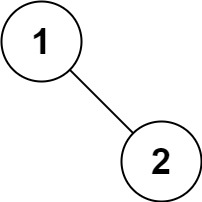
📢 preface
| 🚀 Algorithm problem 🚀 |
- 🌲 Punching out an algorithm problem every day is not only a learning process, but also a sharing process 😜
- 🌲 Tip: the problem-solving programming languages in this column are C# and Java
- 🌲 To maintain a state of learning every day, let's work together to become the great God of algorithm 🧐!
- 🌲 Today is the 39th day of punching out the force deduction algorithm 🎈!
| 🚀 Algorithm problem 🚀 |
🌲 Example of the original problem: preorder traversal of binary tree
Give you the root node of the binary tree, root, and return the preorder traversal of its node value.
Example 1:

Input: root = [1,null,2,3] Output:[1,2,3]
Example 2:
Input: root = [] Output:[]
Example 3:
Input: root = [1] Output:[1]
Example 4:

Input: root = [1,2] Output:[1,2]
Example 5:

Input: root = [1,null,2] Output:[1,2]
Tips:
- The number of nodes in the tree is in the range [0, 100]
- -100 <= Node.val <= 100
🌻 C# method: recursion
Train of thought analysis
The fast and slow pointer starts from the node at the same time. The fast pointer takes two steps at a time and the slow pointer takes one step at a time. If there is a ring, the fast pointer will catch up with the slow pointer sooner or later.
code:
public class Solution
{
private IList<int> res = new List<int>();
public IList<int> PreorderTraversal(TreeNode root)
{
Traversal(root);
return res;
}
private void Traversal(TreeNode node)
{
if(node!=null)
{
res.Add(node.val);
PreorderTraversal(node.left);
PreorderTraversal(node.right);
}
}
}
results of enforcement
adopt Execution time: 224 ms,At all C# Defeated 70.79% of users in submission Memory consumption: 29.8 MB,At all C# Defeated 79.47% of users in submission
🌻 Java method 1: recursion
Train of thought analysis
First of all, we need to understand what is the preorder traversal of a binary tree: we traverse the tree by accessing the root node - left subtree - right subtree, and when accessing the left subtree or right subtree, we traverse in the same way until we traverse the whole tree.
Therefore, the whole traversal process has the nature of recursion. We can directly simulate this process with recursive functions.
Define preorder(root) to represent the answer to the current traversal to the root node. According to the definition, we only need to add the value of the root node to the answer first, then recursively call preorder(root.left) to traverse the left subtree of the root node, and finally recursively call preorder(root.right) to traverse the right subtree of the root node. The condition for recursive termination is that it encounters an empty node.
code:
class Solution {
public List<Integer> preorderTraversal(TreeNode root) {
List<Integer> res = new ArrayList<Integer>();
preorder(root, res);
return res;
}
public void preorder(TreeNode root, List<Integer> res) {
if (root == null) {
return;
}
res.add(root.val);
preorder(root.left, res);
preorder(root.right, res);
}
}
results of enforcement
adopt Execution time: 0 ms,At all Java Defeated 100 in submission.00%User Memory consumption: 36.6 MB,At all Java Defeated 59 in submission.89%User
Complexity analysis
Time complexity: O( n ),among n Is the number of nodes in the binary tree Space complexity: O( n )
🌻 Java method 1: iteration
Train of thought analysis
We can also implement the recursive function of method 1 in an iterative way. The two methods are equivalent. The difference is that a stack is implicitly maintained during recursion,
When iterating, we need to explicitly simulate the stack. The rest of the implementation and details are the same. For details, please refer to the following code
code:
class Solution {
public List<Integer> preorderTraversal(TreeNode root) {
List<Integer> res = new ArrayList<Integer>();
if (root == null) {
return res;
}
Deque<TreeNode> stack = new LinkedList<TreeNode>();
TreeNode node = root;
while (!stack.isEmpty() || node != null) {
while (node != null) {
res.add(node.val);
stack.push(node);
node = node.left;
}
node = stack.pop();
node = node.right;
}
return res;
}
}
results of enforcement
adopt Execution time: 0 ms,At all Java Defeated 100 in submission.00%User Memory consumption: 36.9 MB,At all Java Defeated 5 in submission.45%User
Complexity analysis
Time complexity: O( n ),among n Is the number of nodes in the binary tree Space complexity: O( n )
💬 summary
- Today is the 39th day of punching out the force deduction algorithm!
- This paper uses C# and Java programming languages to solve problems
- Some methods are also written by Likou God, and they are also shared while learning. Thanks again to the algorithm bosses
- That's the end of today's algorithm sharing. See you tomorrow!

🚀 Previous high-quality article sharing
- ❤️Unity zero foundation to entry | systematic learning route of game engine unity from 0 to 1 [comprehensive summary - suggestions collection]!
- 🧡Spend a day doing a high-quality aircraft war game and have a complete tutorial of 10000 words Unity! Beautiful Xuemei looked and called 666!
- 💛Back to childhood classic series ☀️| [bomb man game] production process + analysis | collect it and dream back to childhood with your former friends!
- 💚A first person shooting game Demo similar to CS made all night! It's not difficult to play games
- 🤍Explosive liver wrote a real-time combat game Demo similar to the Royal war all weekend! More than 20000 word game production process + analysis!
- 💙How to make a horizontal arcade fighting game similar to "dinosaur quick fight"| Learn together and send the source code by the way [code text is not easy, it is recommended to collect and learn]
- 💜Back to childhood classic series ☀️| [Snake game] nearly 20000 words complete production process + analysis + source code [recommended collection and learning]